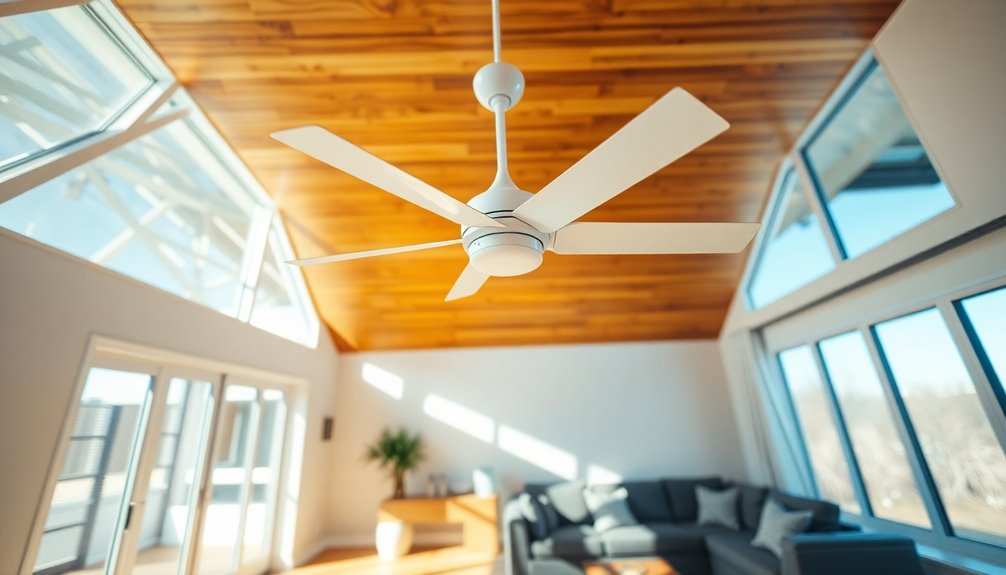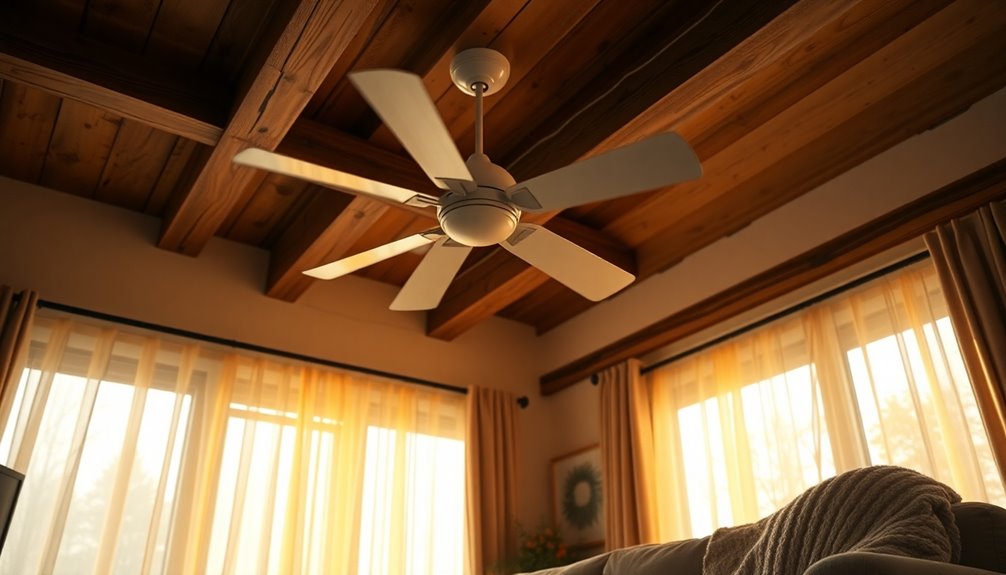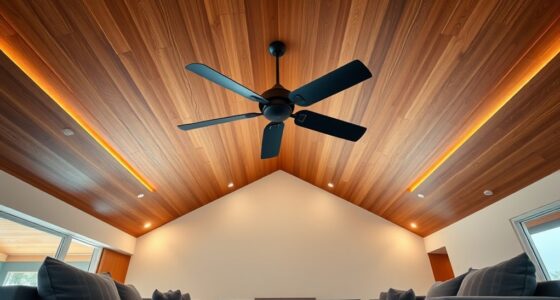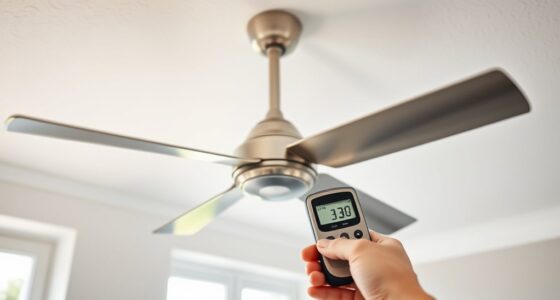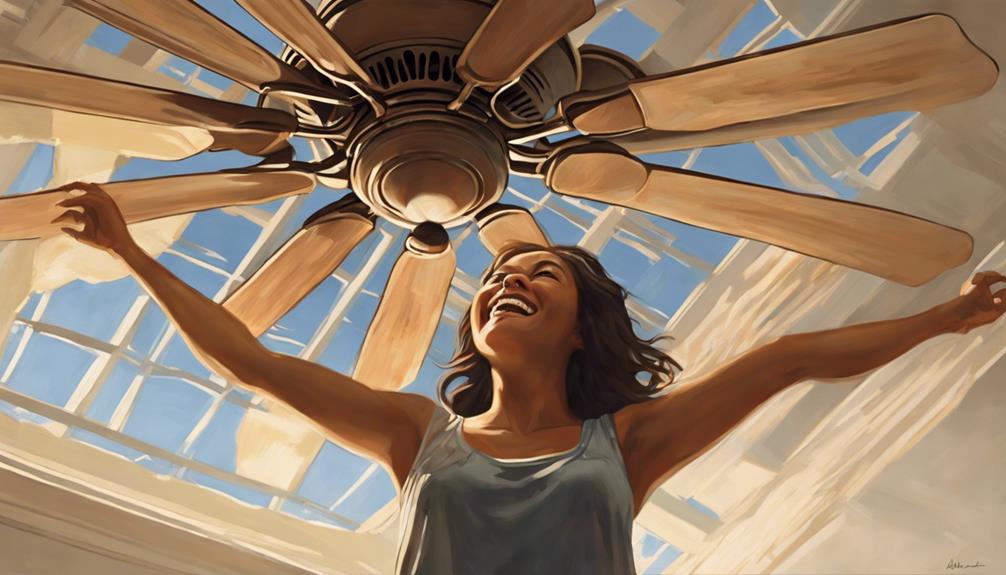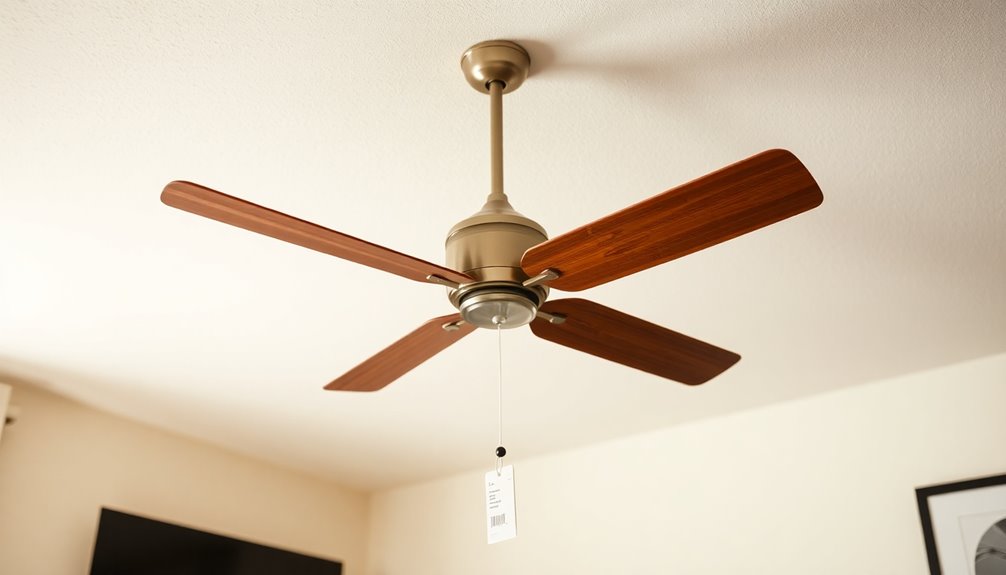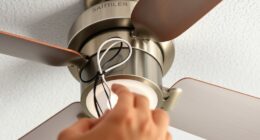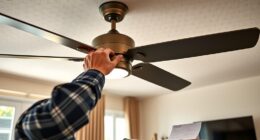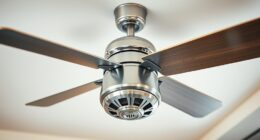Ceiling fan installation usually costs between $144 and $353. This range can vary based on factors like whether you need new wiring or how complex the installation is. For example, standard fans might cost $50 to $300, while outdoor or specialized fans can push costs higher. If you're considering features like built-in lights or remote control, expect to add another $100 to $300 each. It's important to budget for possible extra expenses, too. If you're curious about ways to keep costs manageable, there's more information available to help you make informed decisions.
Key Takeaways
- Ceiling fan installation costs typically range from $144 to $353, with an average cost of $248.
- Complex installations or features like built-in lights can increase costs by $100-$300 each.
- Professional installation fees generally fall between $100 and $500, depending on complexity and local rates.
- Existing wiring can reduce installation costs to $100-$300, while new wiring may elevate costs to $500-$1,500.
- DIY installation can save $50 to $200 on labor but requires electrical knowledge and tools for safety.
Cost Overview of Installation

When considering the cost of ceiling fan installation, you'll find that prices typically range from $144 to $353, with the average installation landing around $248.
If you already have existing wiring, you might reduce your ceiling fan installation costs to between $100 and $300. However, if you need new wiring, be prepared to potentially spend up to $2,000.
Standard ceiling fans generally cost between $50 and $300 for installation.
But if you opt for more complex designs, like directional or hanging propeller fans, the average cost to install can rise to between $150 and $800.
Don't forget about additional features, either. Built-in lights or extra switches can add anywhere from $100 to $300 each to your overall installation cost.
For outdoor ceiling fans, installation prices can vary greatly, ranging from $70 to over $4,000, depending on specific requirements and specifications.
To guarantee you're getting the best results, consider hiring a professional installation service to handle the complexities, especially if you're dealing with new wiring or unique fan designs.
This way, you can enjoy your new ceiling fan without any hassle.
Factors Influencing Costs

When you're considering ceiling fan installation, labor rates can vary greatly based on where you live.
Additionally, the wiring requirements play an essential role in determining your overall costs, especially if you need new wiring.
Understanding these factors can help you budget more effectively for your installation project.
Labor Rate Variations
Understanding the variations in labor rates for ceiling fan installation can save you money and guarantee you get the best service. Labor costs typically range from $50 to $200, influenced by factors like the professional's expertise, the complexity of the installation, and the accessibility of the installation site. Urban areas usually see higher rates than rural regions.
Here's a breakdown of key factors affecting labor rates:
| Factor | Impact on Labor Costs |
|---|---|
| Professional Expertise | Higher rates for licensed electricians |
| Installation Complexity | More intricate setups increase costs |
| Installation Site Accessibility | Difficult access raises labor fees |
| Additional Features | Extra switches can add $100-$200 |
| Bulk Installations | Discounts may apply for multiple fans |
Hiring a licensed electrician can elevate your costs, but their expertise guarantees safety and compliance. If you need multiple fans installed, scheduling them at once could help minimize overall labor costs by reducing travel fees. Understanding these variations allows you to make informed decisions and potentially save on your installation project.
Wiring Requirements Impact
Wiring requirements play an essential role in determining the overall cost of ceiling fan installation. If you're using existing wiring, your installation costs can be quite manageable, averaging between $100 and $300.
However, if new wiring is necessary, you might find yourself facing considerably higher expenses, ranging from $500 to $1,500, depending on the complexity of your project.
The presence of ceiling boxes is also important. If your home lacks a fan-rated junction box and brace, you'll need to factor in these additional costs.
Additionally, if you want separate controls for your lights and fan, be prepared for extra installation costs between $100 and $200 for switches.
If you're considering an outdoor ceiling fan, specialized wiring is often required. This can further inflate your budget, with total costs potentially exceeding $4,000 based on your specific needs.
Ultimately, understanding these wiring requirements will help you plan your budget effectively and guarantee a smooth ceiling fan installation process.
Types of Ceiling Fans

Ceiling fans come in various types, each designed to suit specific needs and spaces. Among the most common are standard ceiling fans, which range from $50 to $300 and often come with light fixtures. They're versatile, making them a great choice for most rooms.
If you have low ceilings, consider low-profile ceiling fans, also priced between $50 and $300. These fans provide efficient airflow without being obtrusive.
For areas requiring adjustable airflow, directional ceiling fans are a solid option. Priced from $150 to $800, they can adapt to various room layouts.
If you have high ceilings, hanging propeller fans are ideal, offering powerful airflow for larger spaces at a cost of $150 to $550.
When it comes to outdoor spaces, you'll want outdoor ceiling fans, designed to withstand the elements. Their prices can range considerably, starting around $250 and going over $3,000, depending on durability and features.
Understanding the types of ceiling fans available will help you choose the right one for your needs, ensuring comfort and style in your home or outdoor area.
Installation Process

Before you start installing your ceiling fan, you'll want to assess the existing wiring and ceiling height to make sure everything's compatible.
Grab essential tools like a screwdriver, drill, and wire stripper, as you'll need them for mounting the fan and connecting the wires.
Taking these pre-installation steps will set you up for a smoother installation process.
Pre-Installation Assessment Steps
A thorough pre-installation assessment is essential for a successful ceiling fan setup. Start by checking the existing wiring's condition and compatibility with your new fan. This guarantees both safety and functionality during operation.
Next, measure the ceiling height; this will help you determine the appropriate type of fan and whether you need any downrods for proper installation.
Don't forget to inspect the ceiling joists. They must be sturdy enough to support the weight of the fan, especially if you've chosen a larger model or one with additional features like lights.
Additionally, take a moment to assess the room's layout and airflow patterns. This can greatly influence your choice of fan size and placement for ideal air circulation.
Finally, review local building codes and regulations. Confirming compliance during your pre-assessment can save you from potential issues later on.
Essential Tools Required
With all the pre-installation assessments complete, it's time to gather the tools you'll need for the ceiling fan installation.
Start by picking up a screwdriver and a drill, as these are vital for securing the fan to the mounting bracket. You'll also need a wire stripper to prepare the electrical connections, and a voltage tester to guarantee safety before you start working with wires.
Don't forget a sturdy ladder to help you reach the ceiling safely, especially if the fan is mounted high.
Electrical tape is essential for insulating and securing wire connections, preventing any accidental contact. A level will help make sure your fan hangs straight, which is important for effective operation and to avoid wobbling.
If your installation requires additional support, a fan-rated junction box and fan brace may be necessary.
Be certain to have the specific tools for these components on hand. Gathering these tools ahead of time will streamline your installation process and help guarantee everything goes smoothly.
Preparing properly sets you up for a successful ceiling fan installation.
Additional Installation Considerations

When planning your ceiling fan installation, it's essential to evaluate several factors that could impact the overall cost. One of the key additional installation considerations is whether you need to remove an old fan or make ceiling modifications. This can add between $100 and $300 to your installation costs.
If you're considering replacing a ceiling fan, think about installing multiple fans at once. This approach can minimize travel fees and provide a more cost-effective solution for larger spaces.
You should also check local building codes before you start. Compliance might require adjustments that could affect your overall costs. Additionally, keep in mind that seasonal pricing fluctuations can influence installation costs, with better deals often available during off-peak times.
Finally, verify your ceiling box can support the weight and operation of the fan. If it isn't adequate, you might need to purchase a fan-rated junction box and brace, which can add an extra $50 to $100 to your total expenses. Moreover, consider consulting with an expert to ensure your installation meets energy-efficient technology standards, which can enhance performance and reduce long-term costs.
Cost Breakdown

Understanding the cost breakdown for ceiling fan installation is essential for budgeting your project. The average ceiling fan installation cost typically falls between $144 and $353, with most jobs averaging around $248.
If you already have existing wiring, you might find installation costs as low as $100 to $300. However, if new wiring is required, expect the cost to soar up to $2,000.
Additional features can further impact your budget. For instance, built-in lights or switches can add anywhere from $100 to $300 each to your total.
If you're considering remote control options for your ceiling fan, those typically range from $150 to $300, which can greatly raise the overall cost.
For outdoor installations, prices fluctuate widely, starting at $70 and potentially exceeding $4,000, depending on the specifications and complexity.
Budget Management Tips

Managing your budget effectively for ceiling fan installation can save you significant money in the long run. Start by establishing a clear budget that estimates your total installation costs, typically ranging from $144 to $353 for professional services.
Don't forget to factor in additional expenses for features like built-in lighting or remote controls, which can add $100-$300 each.
Consider installing multiple ceiling fans at once. This can help you reduce hourly contractor rates and minimize travel fees, leading to greater overall savings.
If possible, utilize existing wiring to lower installation costs to between $100-$300, instead of the up to $2,000 it could cost for new wiring.
It's also wise to plan for unexpected costs by setting aside an additional 10-20% of your budget. This way, you won't be caught off guard by unforeseen expenses during the installation process.
Finally, keep an eye on local pricing trends and seasonal sales to purchase your ceiling fans and installation services at a discount. Additionally, improving indoor air quality can enhance the overall comfort of your living space after installation.
Hiring Professionals vs. DIY

Choosing between hiring a professional or taking the DIY route for ceiling fan installation can considerably impact your budget and overall experience.
If you opt for a professional, you'll typically spend between $100 and $500, depending on the complexity of the installation. Professionals guarantee that everything complies with local codes, especially for ceiling fan replacement that requires new wiring or complex setups. They usually take 1-2 hours for basic installations, which can save you from potential safety hazards.
On the other hand, going the DIY route can save you $50 to $200 on installation labor, but it comes with its own set of challenges. You'll need some level of electrical knowledge, and purchasing tools or materials can add to your expenses.
While it might seem appealing to save money, improper installation could lead to safety risks or even damage to your home.
Ultimately, weigh your skills and the complexity of the job against your budget. If you're confident in your abilities and the installation seems straightforward, DIY might be a good option. However, for peace of mind and safety, hiring a professional is often the better choice.
Frequently Asked Questions
How Much Should I Expect to Pay to Have a Ceiling Fan Installed?
When you're looking to install a ceiling fan, the costs can vary widely.
If you have existing wiring, you might pay between $100 and $300. For new wiring, expect costs to rise considerably.
Additional features like lights or remotes can add $100 to $300 each.
Labor costs also depend on where you live and the complexity of the job, typically ranging from $50 to $200.
Always get multiple quotes to find the best deal.
How Much Does Home Depot Charge to Install a Fan?
When you're considering having a fan installed at Home Depot, you can expect charges to range from $144 to $353, with an average fee around $248.
If you've got existing wiring, it might lower your costs to between $100 and $300.
Keep in mind that adding features like built-in lights can add $100 to $300 each, and if new wiring's needed, costs can skyrocket, potentially reaching up to $2,000.
Should You Hire an Electrician to Install a Ceiling Fan?
You might think installing a ceiling fan is a breeze, but it's wise to take into account the hidden complexities involved.
Hiring an electrician guarantees your installation's not just quick but also safe and up to code. They can handle tricky wiring and specialized features like separate controls effortlessly.
While DIY may seem tempting, it could lead to unexpected headaches if you're not experienced with electrical work.
Do You Need an Electrician to Fit a Ceiling Fan?
You don't always need an electrician to fit a ceiling fan, especially if you're using existing wiring and have some DIY skills.
However, if your installation involves new wiring, complex setups, or features like remote controls, it's wise to consult a licensed electrician. They guarantee safety, compliance with local codes, and ideal placement.
Even if you feel confident, a professional can help avoid potential hazards and guarantee everything functions correctly.
Conclusion
To sum up, installing a ceiling fan can be as invigorating as a cool breeze on a hot summer day. By understanding the costs involved and the factors that influence them, you can make an informed decision that fits your budget. Whether you choose to hire a professional or tackle the installation yourself, being prepared will guarantee a smooth process. So, take your time, weigh your options, and enjoy the comfort a ceiling fan brings to your space!
